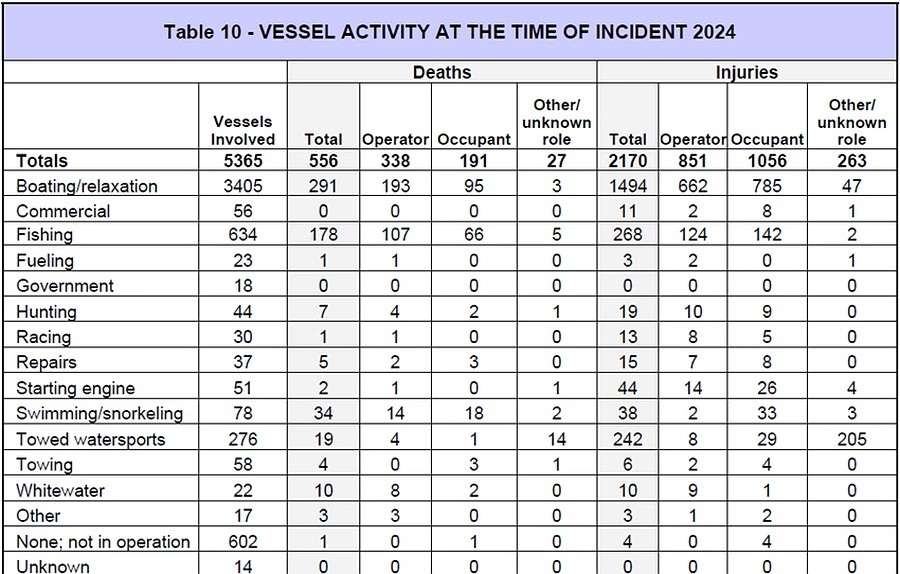
One of the first things boating incident investigators do is try to determine what was going on at the time the incident occurred. To be included in the Boating Statistics, there must be an incident that involves a death, an injury, or signification damage to a vessel. This article will look at the vessel activity at the time of the incident and the resultant deaths or injuries. And further breaks the incident down into death or injuries to the occupant or the operator.

Main Takeaways from This Table
You do not have to be a statistician to learn from this table. As a boat operator, you should realize from this table that you hold the lives of your passengers in your hands. Every occupant death or injury documented in this table involved an operator. As an occupant, you should realize that you should choose your captain wisely. Before you hop in your neighbor’s new boat for a ride, ask if your neighbor has the required Boater Safety Certificate, whether they are familiar with the area of operation, whether they have the required safety equipment, and ask how much experience they have as a boat operator. You would not hop into his new (to him) Cessna 172 without determining the above. Many people tend to minimize the dangers of operating or riding in a boat. After all, water is soft, you can swim, and you will not be running 85 mph (legal limit in Texas on some highways).
Table Layout
Before actually discussing the statistics, I will first discuss the layout of the table. If you look at the far-left column, which lists the different vessel activities, you should note that the list is not in order of severity but is in alphabetical order. That is because this list is used from year to year and the categories are set.
Look at the Commercial category. Yes, this study is about recreational boating, but sometimes recreational boats run into commercial boats or are run over by commercial boats. Look at the Government category: it is zeroes all the way across yet it shows eighteen vessels involved. Although there were no injuries or deaths, there were some damages (the third of the Deaths/Injuries/Damages categories); we are just worried about deaths and injuries, but keep in mind that you do not want to run into a government vessel.
Now that we understand how the table is laid out, let’s look at some of the “big” categories: (1) Boating/relaxation, (2) Fishing, and (3) Towed watersports.

Boating/relaxation
I call this the Cruising category. Everyone should be just riding at a moderate speed for the water conditions (it could be 10 mph; it could be 30 mph; just not fast for the circumstances). So, what could cause death and injury here? The usual incidents are:
- Collision with another vessel
- Collision with a fixed object (dock, jetty, Aid to Navigation, etc.)
- Overloaded boat
- Grounding
The usual causes of the above are:
- Operator inattention
- Failure to provide a proper lookout
- Improper loading
- Running too fast in unfamiliar waters
Mitigating Strategies include:
- Remove distractions; keep your eyes on the water
- Assign one or more passengers to be a lookout
- Follow the manufacturer’s passenger loading guide
- Take someone with you who is familiar with the area and slow down

Fishing
You may wonder why this is a separate categy from cruising. After all, you are just running along in a boat. But there are some differences. Fishermen are often running wide open to be the first boat to get to a particular location because that is where the fish are. They stand a higher chance of death, injury, or damage whenever their speed is greater than cruising speed. The faster you go, the narrower your field of vision.
Fishermen are more likely to run at night because everyone knows the fish eat breakfast at daylight, so you have to run in the dark to get there and be ready for the feeding frenzie. I am one of those early fishermen. I often see fishermen running at night with no navigation lights. After all, it will only be for a few minutes and you have to dig that anchor light out of the side compartment and it has 3 kids’ life jackets and two rods on top of it (I have heard all the excuses). Use your nav lights and slow down.
There are oyster reefs that everyone in my area like to fish. They are usually large enough to hold 10-20 boats fishing. I have come up on my favorite reef to find 20 boats full of fishermen, or about 60 people. Of those 60 fishermen, absolutely none of them would have a life jacket on. Although some might wear a lifejacket whike the boat is moving, almost 100% of the fishermen remove their lifejackets when they stop. It’s hot, they need to free up their arms for casting, it’s not necessary when we are stopped. It took me years and the death of the local chief of police to get my neighbors to understand that when you are walking all over the top of your boat with a big redfish on the end of the line, you are quite likely to fall overboard, and you will almost certainly hit your head on the gunwale as you go over. You will sink and your buddies won’t be able to find you.
The mitigating strategies for operating a fishing boat are the same as above when moving. However, when you stop and anchor or slowly drift, you should keep in mind that it is never safe to take off your lifejacket whether you are moving or anchored. If you are going to move all about the boat when fighting a fish, be sure to have tripping hazards removed. Close and store your tacklebox and put those spare rods in rod holders. Remind passengers to watch out for slippery decks if you have fish jumping about as you try to remove the hook and put them in the box.
Remember that lookout you assigned when you were running? Be sure to remind them that they are still on lookout duty as is everyone else on the boat. You still have to worry about getting hit by a boat that is underway but not under control.

Towed Watersports
Around twenty years ago I was looking at boats. I wanted to buy a center console fishing boat, but my wife said no, get a pontoon boat for the grandkids. I ended up getting a fishing model pontoon boat. It had a live well and three fishing seats. It was also set up for hauling all the grandkids and a large 3-person tube for tubing. It was a great boat with one exception: when the grandkids were riding the tube without exception they all yelled, “Faster, Grandpa, faster!” I found out I could sling them faster by running in circles. That worked out okay on the big lake near our home, where we could get so far away from other boats that there was no danger of a collision. I still had a couple of lookouts.
The problem with towing tubes, skiers, knee boards, etc., is that there is 50-100 feet of space between the towing boat and the watersport rider. That means that a lot more open water is needed to tow these rides safely, and lakes, rivers, and the open sea can quickly become overcrowded, making watersport towing more unsafe with each addition to the fleet of tow boats on any body of water, with each boat making circles, figure eights, and turns while pulling up to five riders or more. Any boat operator trying to get past a boat towing riders is at the mercy of the tow boat. They depend on the tow boat to recognize that they want to get past them and for the tow boat to stop, slow, or modify its heading.
Courtesy is the key to safety in the category of towed watersports. As the boat operator you are responsible for the safety of everyone aboard and everyone in the water. Don’t put your passengers in the water if the area is crowded. If someone is within around a quarter mile of your boat, you probaby don’t have enough room to safely tow anyone, especially your own kids and grandkids.
Summary
The Boating Incident Statistics for 2024 are the latest statistics for which we have a full year of data. While the report can be used by anyone, it is designed to help Recreational Boating Safety specialists to plan their actions for the next twelve months. I encourage boaters to make their own safety plans by reviewing the data, recognize the unsafe situations they often encounter, and mitigate their own exposure to unsafe activities.





Joel Stockton
August 5, 2025 at 7:12 amThese are very informative and useful statistics, thank you.
What geographical area do these stats cover?
J. Lee Austin
August 5, 2025 at 9:51 amGood stuff as always, Bob. As a survivor of a high speed nocturnal grounding accident, I really appreciate your data and analysis. Keep up the good work!
~~ j ~~